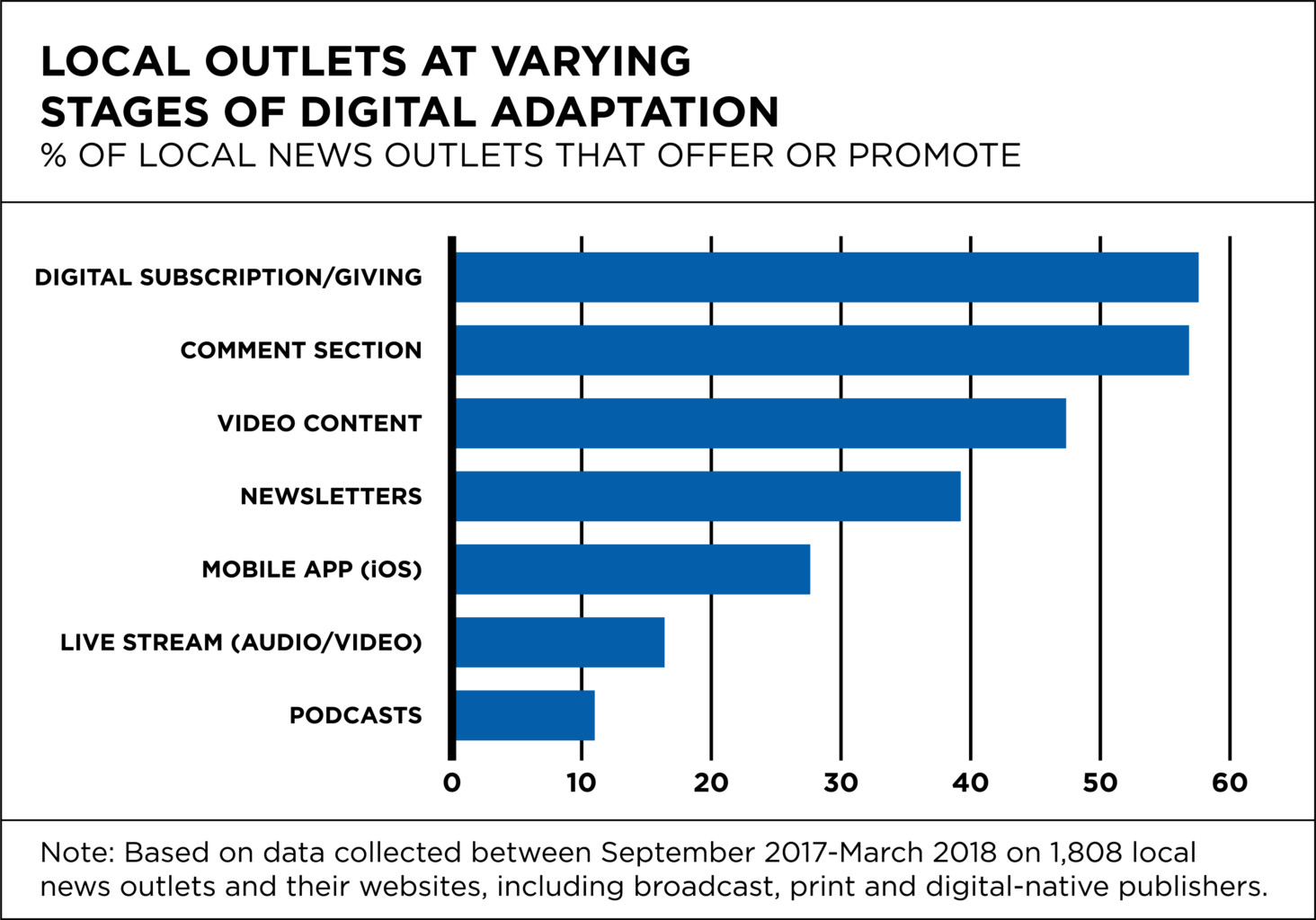
So you want to support local news. But can you even find the subscribe button on the Daily Planet’s clunky website to do so?
Is the website optimized for a smartphone? (Which is, of course, what you’re probably trying to use to find said button.) Does the organization even have a website, or does it shoot straight to social media instead of fighting with a WordPress template?
If you answered “uh, don’t know” or “eek, no” or “maybe I can for one site but I care about strengthening local news more broadly,” then you might want to check out this new research from Calvin College professor Jesse Holcomb, published over at Columbia University’s Tow Center.
Holcomb — who spent 10 years as a researcher at Pew before going to Calvin — examined 2,072 local news outlets, a sample drawn from Cision’s media database. (He defined “local” as “if it covered affairs in a single neighborhood, municipality, metropolitan area, and in some cases even state affairs.”) Out of those, only 1,814 even had a website — 12 percent of all local news outlets don’t, but apparently if you include PDF versions that bumps it up to 17 percent. Because PDF versions are really what we all need.
News on the internet has been around for — well — several decades. But it’s no surprise that local news outlets — stymied by scale and ownership, and often serving audiences behind the digital curve — have not been able to adapt to the age as quickly as national organizations. Projects like the Knight-Lenfest Newsroom Initiative, a.k.a. Table Stakes, have helped newsrooms lurch along the digital transformation. (And soon news organizations will be able to share lessons in a technology resource hub, in a new infusion from Knight and Lenfest. Disclosure: Knight has supported Nieman Lab in the past.)
How do online offerings for local news stack up now? Holcomb’s top findings:
- More than one in ten (12 percent) local news outlets do not have their own website; when outlets are accounted for that only offer a PDF of their recent content, that figure rises to 17 percent.
- Most local media are on social media. Nearly eight in ten local news outlets have their own Facebook profile. Even outlets without their own website are on the social networking site—fully one in three (34 percent).
- When it comes to mobile, responsive design is more common (84 percent of local news sites) than individual apps (27 percent of local news outlets). Fully 74 percent of local TV stations offer their own app.
- Overall, a slight majority of local news outlets (57 percent) offer an online pathway to subscription, donation or membership. This varies wildly depending on the sector, with broadcasters highly unlikely to do so, and daily newspapers highly likely.
- Local news websites are generally split when it comes to their commenting architecture—a small majority (56 percent of outlets) offer comment sections on their stories. (On local TV station websites, the share is just 29 percent).
- Just under half (47 percent) of local news outlets offer video on their site. Of those that do, 44 percent host their videos on YouTube.
- Links to live-streams of video or audio (16 percent) and podcasts (11 percent) are fairly uncommon among local news websites, though unsurprisingly, appear more frequently on sites operated by broadcasters.
- On average, daily newspaper and local TV station websites are the slowest to load, at more than 20 seconds each, by one measure. Digital native publishers, and community weeklies and magazines tend to load faster, at a rate of between 13-15 seconds each.
- Only about a quarter (23 percent) of local news websites redirect to a secure version. Overall, about four in ten (39 percent) local news outlets offer or promote a newsletter product on their website. Daily newspapers (65 percent) and digital native publishers (57 percent) lead the way here.
The study also points out that Google’s “many tentacles in the online local news space are striking: Not only are publishers indexed in Google’s search engine and their pages’ loading times optimized by Google’s AMP project, but Google advertising services appear on many local news websites. Further, nearly half of all local news websites that offer online video host it on YouTube, which is owned by Google.” (The study used Google’s Lighthouse dev tools to gather technical data, ironically enough.)
For our Predictions for Journalism 2018 series last December, Holcomb offered up one of the most dire forecasts: “Information disorder, coming to a congressional district near you.”The malaise that transformed American politics into a hall of mirrors during the leadup to the 2016 presidential election will increasingly afflict local communities.
Why? The social platforms that became vectors for misinformation and its evil twin, disinformation, are widely used not just for national news, but also for community information. Those platforms are not in retreat but rather are ascendant as a news source among certain populations, including older adults, and are unlikely to be constrained by a regulatory framework anytime soon.
What’s more, the upcoming 2018 midterm elections, which will bring partisan politics to the district level amidst a hobbled local news industry, leave American communities ripe for exploitation by bad actors capitalizing on our worst impulses.
If that scenario is to be avoided, local news sites will need a more robust digital presence. Read the full report here.